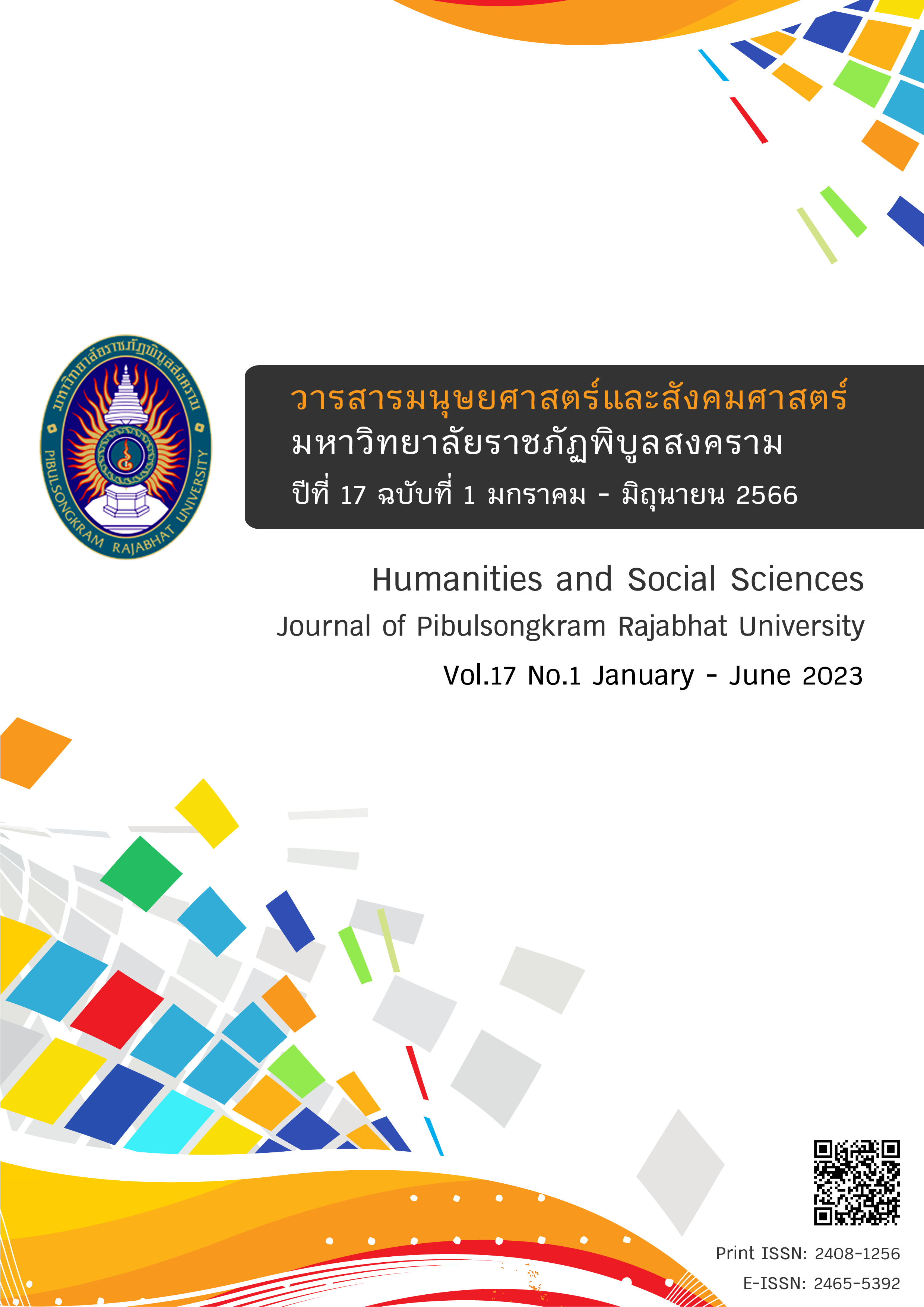ความสัมพันธ์ระหว่างประสิทธิภาพการสื่อสารของผู้สอบบัญชี สายสัมพันธ์ระหว่างผู้สอบบัญชีและผู้บริหาร และการรับรู้คุณภาพการสอบบัญชีของผู้บริหารวิสาหกิจขนาดกลางและขนาดย่อมในจังหวัดเชียงใหม่
DOI:
https://doi.org/10.14456/psruhss.2023.19คำสำคัญ:
ประสิทธิภาพการสื่อสาร , การรับรู้คุณภาพการสอบบัญชี , สายสัมพันธ์ , วิสาหกิจขนาดกลางและขนาดย่อมบทคัดย่อ
งานวิจัยนี้มีวัตถุประสงค์เพื่อศึกษาถึงความสัมพันธ์ระหว่างประสิทธิภาพการสื่อสารของผู้สอบบัญชี (รูปแบบการสื่อสาร การจัดหาข้อมูล และบทสนทนาทางสังคม) สายสัมพันธ์ระหว่างผู้สอบบัญชีและผู้บริหาร และการรับรู้คุณภาพการสอบบัญชีของผู้บริหารวิสาหกิจขนาดกลางและขนาดย่อมที่ดำเนินธุรกิจในรูปแบบของนิติบุคคลในจังหวัดเชียงใหม่ โดยการใช้แบบสอบถามเป็นเครื่องมือในการเก็บรวบรวมข้อมูลจากผู้บริหารของธุรกิจที่มีส่วนร่วมในกระบวนการสอบบัญชี จำนวน 171 ราย และนำข้อมูลที่ได้มาวิเคราะห์ผลโดยใช้โมเดลสมการโครงสร้าง ผลการศึกษาพบว่า ประสิทธิภาพการสื่อสารในด้านรูปแบบการสื่อสาร และด้านการจัดหาข้อมูลมีความสัมพันธ์ในเชิงบวกกับสายสัมพันธ์ของผู้สอบบัญชีและผู้บริหาร และการรับรู้คุณภาพการสอบบัญชีอย่างมีนัยสำคัญทางสถิติ ในขณะที่ประสิทธิภาพการสื่อสารในด้านบทสนทนาทางสังคม ไม่มีความสัมพันธ์กับสายสัมพันธ์ของผู้สอบบัญชีและผู้บริหารอย่างมีนัยสำคัญทางสถิติ แต่มีความสัมพันธ์เชิงลบกับการรับรู้คุณภาพการสอบบัญชีอย่างมีนัยสำคัญทางสถิติ นอกจากนี้ยังพบว่าสายสัมพันธ์ของผู้สอบบัญชีและผู้บริหารไม่มีความสัมพันธ์กับการรับรู้คุณภาพการสอบบัญชีอย่างมีนัยสำคัญทางสถิติ
เอกสารอ้างอิง
นฤนาถ ศราภัยวานิช, มนทิพย์ ตั้งเอกจิต, สุวรรณา เลาหวิสทุธิ์ และวรัทยา แจ้งกระจ่าง. (2555). ความสัมพันธ์ระหว่างการสื่อสารระหว่างบุคคล การรับรู้ถึงคุณภาพการสอบบัญชี และการใช้บริการสอบบัญชีของผู้ประกอบการวิสาหกิจขนาดกลางและขนาดย่อมในประเทศไทย. วารสารคณะวิทยาศาสตร์การจัดการและสารสนเทศศาสตร์, 7(2), 49-58.
นฤนาถ ศราภัยวานิช. (2556). คุณภาพงบการเงินของวิสาหกิจขนาดกลางและขนาดย่อมในประเทศไทย. วารสารบริหารธุรกิจ เศรษฐศาสตร์และการสื่อสาร, 8(2), 21-30.
พิริยะ ผลพิรุฬห์. (2556) .บทบาทของวิสาหกิจขนาดกลางและขนาดย่อมไทยในระบบเศรษฐกิจสร้างสรรค์. วารสารเศรษฐศาสตร์ปริทรรศน์ สถาบันพัฒนศาสตร์, 7(1), 205-250.
ศุภรัศมิ์ ฐิติสกุลเจริญ. (2554). ทฤษฎีการสื่อสาร. (พิมพ์ครั้งที่ 3).กรุงเทพ: มหาวิทยาลัยเกษตรศาสตร์.
สถาบันพัฒนาและสนับสนุนผู้ประกอบการ SME (2561) .ธุรกิจน่าลงทุน เชียงใหม่. สืบค้น 3 กรกฎาคม 2561, จาก https://taokaemai.com.
สำนักงานส่งเสริมวิสาหกิจขนาดกลางและขนาดย่อม (2563). รายงานประจำปี 2562. สืบค้น 7 มิถุนายน 2564, จาก https://www.sme.go.th/upload/mod_download/download-20201103152522.pdf.
Aaker, D. A., Kumar, V., & Day, G. S. (2001). Marketing Research (7thed). New York: John Wiley and Son.
Andersen, P. H. (2001). Relationship development and marketing communication: An integrative model. Journal of Business and Industrial Marketing, 16(3), 167–182.
Ben-Sira, Z. (1980). Affective and instrument components in the physician-patient relationship: An additional dimension of interaction theory. Journal of Health and Social Behavior, 21, 170-180.
Benson, L. (1994). Profiting as an investment adviser. Practical Accountant, 27(8), 20–31.
Browne, M. W., & Cudeck, R. (1993). Alternative ways of assessing model fit. In Bollen, K. A. and Long, J. S. (Eds.), Testing structural equation models. Newbury Park (p. 136-162). California: Sage.
DeWitt, T., & Brady, M. K. (2003). Rethinking service recovery strategies: The effect of rapport on consumer responses to service failure. Journal of Service Research, 6(2), 193-207.
Duncan, T., & Moriarty, S.E. (1998). A communication-based marketing model for managing relationships. Journal of Marketing, 62(2), 1-13.
Fornelli, C. (2016). Improving audit quality through auditor communication. The CPA Journal (February), 10-12. Retrieved from https://www.cpajournal.com2016/02/01/improving-audit-quality-auditor-communication/
Gremler, D. D., & Gwinner, K. P. (2000). Customer-employee rapport in service relationships. Journal of Service Research, 3(1), 82-104.
Gronroos. C. (1990). Relationship Approach to Marketing in Service Contexts: The Marketing and Organizational Behavior Interface. Journal of Business Research, 20(1), 3-17.
Hu, L. T., & Bentler, P. M. (1999). Cutoff Criteria for Fit Indexes in Covariance Structure Analysis: Conventional Criteria versus New Alternatives. Structural Equation Modeling: a Multidisciplinary Journal, 6(1), 1-55.
Hair, F. J., Black, C. W., Babin, J. B., & Anderson, E. R. (2010). Multivariate Data Analysis (7thed). Upper Saddle River, New Jersey: Pearson Prentice Hall.
Kirchmajer, L., & Patterson, P. (2004). The role of interpersonal communication in the development of client trust and closeness in a SME professional service context. Small Enterprise Research, 12(1), 45-56.
Larrabee, J. H. (1995). The changing role of the consumer in health care quality. Journal of Nursing Care Quality, 9(2), 8-15.
MacCallum, R. C., Browne, M. W., & Sugawara, H. M. (1996). Power analysis and determination of sample size for covariance structure modeling. Psychological Methods, 1(2), 130–149.
Marsh, H. W., & Hocevar, D. (1985). Application of confirmatory factor analysis to the study of self-concept: First- and higher-order factor models and their invariance across groups. Psychological Bulletin Journal, 97, 562–582.
McEnroe, J. E., & Martens, S. C. (2001). Auditors’ and investors’ perceptions of the expectation gap. Accounting Horizons, 15(4), 345-358.
Sampet, J., Sarapaivanich, N., & Patterson, P. G. (2019). The role of client participation and psychological comfort in driving perceptions of audit quality: Evidence from an emerging economy. Asian Review of Accounting. 27(2), 177-195.
Sarapaivanich, N., Ekasingh, E., & Sampet, J. (2020, January.) Improving audit quality perception through auditor-client social relationship: The mediating role of rapport. Special joint conference 2020 facing the disruptive forces in global business: The way forward, Nairobi, Kenya.
Sarapaivanich, N., & Patterson, P. G. (2016). A contingency model of client repatronage in a financial auditing services context. Accounting Research Journal, 29(1), 106-130.
Sarapaivanich, N., & Patterson, P. G. (2015). The role of interpersonal communication in developing small-medium size enterprise (SME) client loyalty toward an audit firm. International Small Business Journal, 33(8), 882-900.
Sarapaivanich, N., Sampet, J., & Patterson, P. G. (2019). The impact of communication style on psychological comfort and trust in audit services. Accounting Research Journal. 32(4), 642-661.
Sharma, N., & Patterson, P. G. (2000). Switching Costs, Alternative Attractiveness and Experience as Moderators of Relationship Commitment in Professional, Consumer Service. International Journal of Service Industry Management, 11(5), 470-490.
Street, R. L. (1989). Patients’ Satisfaction with dentists’ communicative style. Health Communication, 1(3), 137-154.
Sudman, S. (1976). Quantitative studies in social relations, Applied Sampling. New York: Academies Press.
Wooten, T. (2003). Research about audit quality. Retrieved from http://www.nysscpa.org/cpajournal/2003/0103/dept/d014803.htm.
ดาวน์โหลด
เผยแพร่แล้ว
รูปแบบการอ้างอิง
ฉบับ
ประเภทบทความ
สัญญาอนุญาต
ลิขสิทธิ์ (c) 2022 วารสารมนุษยศาสตร์และสังคมศาสตร์ มหาวิทยาลัยราชภัฏพิบูลสงคราม

อนุญาตภายใต้เงื่อนไข Creative Commons Attribution-NonCommercial-NoDerivatives 4.0 International License.
บทความหรือข้อคิดเห็นใดใดที่ปรากฏในวารสารมนุษยศาสตร์และสังคมศาสตร์ มหาวิทยาลัยราชภัฏพิบูลสงครามเป็นวรรณกรรมของผู้เขียน ซึ่งบรรณาธิการไม่จำเป็นต้องเห็นด้วย บทความที่ได้รับการตีพิมพ์เป็นลิขสิทธิ์ของวารสารมนุษยศาสตร์และสังคมศาสตร์ มหาวิทยาลัยราชภัฏพิบูลสงคราม









